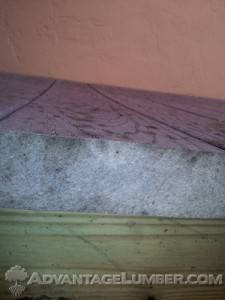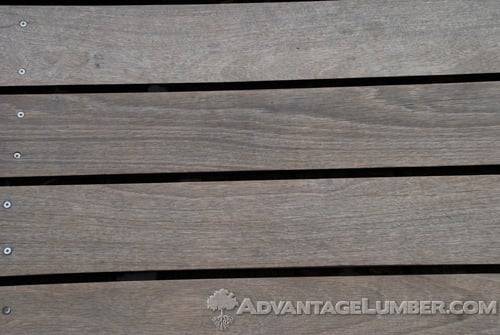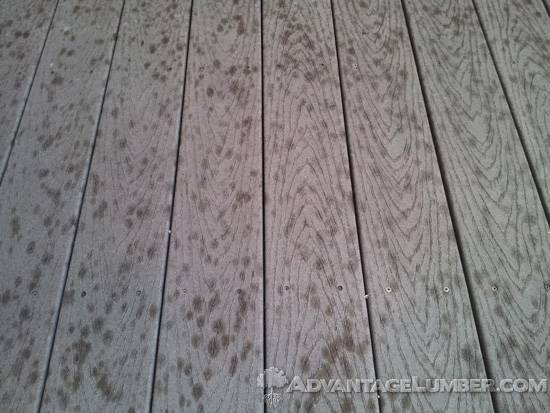
I was walking to my doctor’s appointment when I came across a walkway made of composite decking. The deck boards looked like new…but as you can see, the deck was plagued with these dark grey spots. As I was taking pictures, two women passed me. I overheard one ask, “What the heck is THAT?”
Mold? A chemical reaction of some sort?
While you might read that this kind of problem is strictly a surface problem, this picture (to the right) tells another story.
As you can see, this mold-like substance has actually penetrated through the surface and is present inside the core of these deck boards.
But, still…why?
Think about it. A lot of composite decking is made up of wood fibers. When you combine Florida’s naturally humid climate, soft wood fibers, and ever-present mold spores, this composite deck can be seen as a petri dish for mold and fungus.
For years, composite deck marketing has focused on the product’s longevity, being “eco-friendly,” and its long-lasting look. But if you live in Florida, being aware of these possible problems can be just as important as the initial cost or any short-term savings.
So…this begs the question. If it’s possible for composite decking to react adversely to Florida’s climate, how would Ipe, or Cumaru decking hold up?
Well, let’s take a look at one example:

This is a picture of Ipe wood decking used in the famous Miami Beach boardwalk. As you can see, the boards, while gray, have endured exceptionally well against the elements. And, when you throw in sand, salt water, and the daily pounding it has to endure, it’s amazing how well the wood has held up. Here’s a link to more picture of Ipe decking in Miami.
The secret to the success of hardwoods like Ipe and Cumaru isn’t magic. It’s not anything man-made. It’s simply nature. The oils, tight grain pattern, and high density combine to act as a natural preservative thereby increasing your deck’s overall lifespan and performance.
What do you think? If you’re considering remodeling an old wood deck in Florida, what materials are you considering? What questions do you want answered about hardwood decking? Leave a comment we’ll answer your questions!
Update: Composite decking has changed a lot over the years, and manufacturers are constantly improving the product. Many of the problems that plagued synthetic decking in the past have been solved. But not all companies and products are equal; always do your research, and only buy composite decking from reputable brands!

I live in Alabama and my deck has full sun all day and is covered in mold; I just purchased the lumber last summer.
Hello, I bought the grey decking shown above and it has black spots all over the deck… I purchased from Home depot. I live in Monson Ma.
Is there anything I can do to correct this problem?
Thank you,
Bruce Gustafson
You’ll have to contact the manufacturer and ask what they recommend. Composite decking companies usually offer a specialized cleaning solution that supposedly removes mold spots, at least temporarily.
I’ve lived in far SW Fl (Naples) for 17 yrs.
Never ever saw a spot on miles and miles of the stuff I’ve noticed unreplaced forever. The plastic lumber as I call it all looks better, has aged very well, no checking, bowing,or horrible arsenic splinters, etc. The recycled milk jug plastic type. Maybe other things. That in the sun all day, and that in the shade of the mangroves. Perhaps something different used here?
I also have the composite decking and I live in Roanoke VA. This is what has formed over the past year and a half. But what I will like to find out is could this be toxic and harmful to a person. Because this mold or fungus really look like it could be harmful. And it looks and sounds to me like this is some sort of defect in the composite if so many people have the same issue